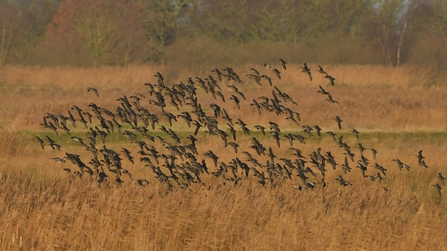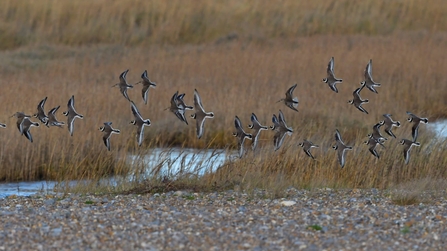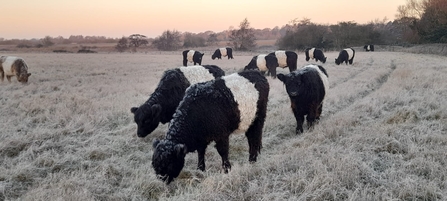Weekly wild news from our reserves - 7 January 2022
Frosty sunrise at Carlton Marshes - Gavin Durrant
The team at Carlton Marshes got an extra special Christmas present this year when this young dog otter calling was caught on the webcam on Christmas Day!
Habitat creation at Carlton Marshes
There is no time to rest for our North East Suffolk team - this week they have been creating muddy edges for breeding waders which we expect to flock to the reserve in spring.
New dykes are also being created; these new homes for wildlife will eventually support plants, dragonflies, aquatic insects, birds, mammals, amphibians and more. Plants and insects will move in first, as they swim, fly and drift from the connecting dykes.
Perk of the job
Warden Gavin enjoyed another otter encounter and was quick enough to get this lovely close-up photo at Peto’s Marsh during his lunch break.

Otter at Peto's Marsh - Gavin Durrant
A lapwing record
Visitor Experience Officer Vicky filmed hundreds of lapwing soaring above Church Farm during the festive break. We don’t remember seeing numbers like this on the reserve previously.
Frosty sunshine
What is more beautiful than a Carlton Marshes sunrise? A frosty Carlton sunrise as shown in these gorgeous scenes.
Pretty dabblers
The teal is our smallest duck. Males are grey, with a speckled breast, a yellow-and-black tail, a chestnut-coloured head and a bright green eye patch. Females are mainly mottled brown, but both sexes show a bright green wing patch in flight. Common and pretty dabbling ducks, teal gather in large numbers on wetlands such as Carlton Marshes. Many of these birds are migrants from the cold climes of the Baltic and Siberia.

Flock of teal at Carlton Marshes – Gavin Durrant
Plover and dunlin
Warden Gavin snapped this flock of ringed plover and dunlin at Dingle Marshes recently.
Plovers forage for invertebrates and crustaceans in a particular way: standing and watching, running forward, pecking, then standing still again. The ringed plover tempts underground prey to the surface by 'foot-trembling': tapping its feet fast on the ground to mimic raindrops.
Dunlin are small sandpipers, which can be found on the coast all year round, preferring estuaries, where they seek out insects, worms and molluscs to eat. In winter, dunlin gather in large flocks and roosts on nearby fields and saltmarshes. In summer, they breed in the uplands of the UK, when they turn brick-red above and sport a black patch on their belly.

Ringed plover and dunlin at Dingle Marshes - Gavin Durrant
What goes up must come down
It’s been a week of spectacular skies; these gorgeous sunsets were taken across our North Suffolk reserves.
Chilly breakfast
Our belted Galloway cattle don’t let the icy conditions interfere with their important job of conservation grazing!

‘Belties’ in the morning frost at Carlton Marshes – Gavin Durrant






